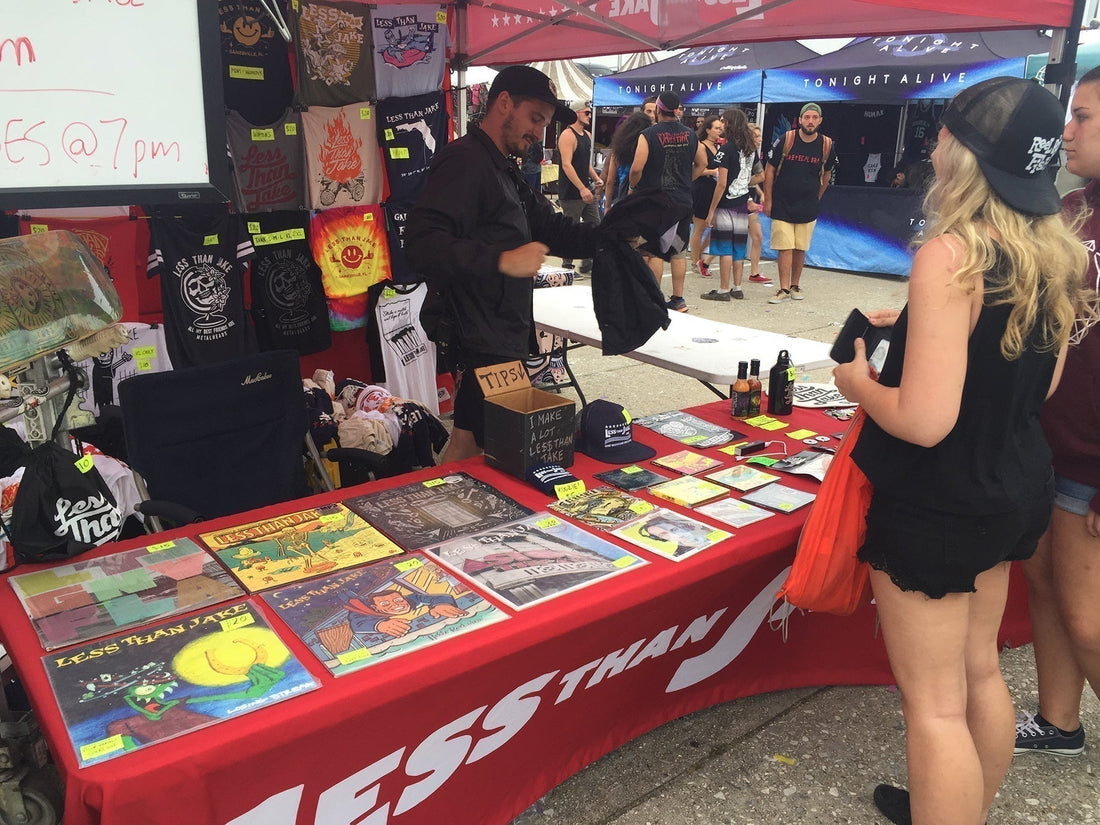Larry Jaffee, co-founder of trade organization Making Vinyl and a contributor to Copper, recently held a seminar at LIU Post college in Brookville, New York as part of the university’s Hutton House Lecture series. The seminar, “Vinyl: the Most Improbable Comeback of the 21st Century,” covered some of the reasons why vinyl has not only returned from what once seemed like its demise, but is thriving, though not without challenges. The following article is based on Larry’s lecture, which editor Frank Doris attended.
Frank Doris: Vinyl records looked like they were in the scrap heap as recently as 15 years ago or so. Now, fans are lining up around the block to buy records. Why?
Larry Jaffee: First, a little about myself. About 10 years ago, I decided to reorient my life and focus entirely on music, because that's what made me happy after writing about cybersecurity for a decade. I co-founded Making Vinyl, a business-to-business conference that started in Detroit in November 2017. We've held conferences in the US and Europe. In 2022, my book Record Store Day: The Most Improbable Comeback of the 21st Century was published, tracing the direct correlation between the vinyl revival and Record Store Day (RSD). The story explains how a group of record store misfits in 2007 were able to move mountains to get the record industry to revive something that they thought nobody cared about.
I became a record collector in 1973 as a 15-year-old, and it changed my life. I started writing professionally about music while still an undergraduate at Hofstra University, where in 1984 I started teaching journalism. My first full-time job covering the music business was as editor of a trade publication covering CD and DVD production, Medialine. I resumed teaching media studies on the college level in 2013 and currently teach a music writing class at St. John's University.
When I was in high school, I desperately wanted to work in a record store, and no one would ever give me a job. Around 2013 I was in the process of selling music memorabilia to Record Reserve in East Northport, Long Island. About a year later, Record Reserve moved to my hometown of Kings Park, which never previously had a record store. Its owner Tim Clair asked me, “Do you want to cover the store for me?” So, there I was, in my mid-50s, finally working in a record store. And I realized that something was missing from my life: records.

Larry Jaffee at the 2022 Making Vinyl conference.
FD: What goes around comes around. The 75th anniversary of the LP was in 2023. The format has become re-established in a major way. How did it happen?
LJ: But first, realize that some of the statistics you’ll see online are nonsense, and vinyl sales are likely much bigger than the announced estimates. Ignore the clickbait headlines. The RIAA (Record Industry Association of America) stated that 43.5 million records were shipped in 2023. This doesn't make any sense. The Vinyl Record Manufacturers Association last year funded a research study to get the actual worldwide production volumes from the pressing plants. With about 40 percent of the data in, we learned that 110 million records were pressed in 2023.
Less than five percent of indie record stores report their numbers to Luminate. There are currently about 200 vinyl pressing plants, whereas in 2017 there were only 35 on both sides of the Atlantic. Making Vinyl estimated in 2023 that more than 200 million records were pressed. New pressing plants are still opening and existing facilities expanded to meet consumer demand during the pandemic.
FD: Why do you say the vinyl comeback is improbable?
LJ: The comeback is improbable for many reasons. Vinyl is expensive: the wholesale price is usually about $10 for a record. It’s environmentally unfriendly, since records are PVC-based. We’re in the digital age, where people can stream music easily. But at this point, no one should debate whether the comeback is real.

Jack White (The White Stripes, The Raconteurs, The Dead Weather, solo artist) at the first Making Vinyl conference in Detroit, Michigan in 2017.
Sales of LPs peaked in 1984. In fact, cassettes were the most popular format in the mid-1980s through early 1990s. In the early 1980s, record labels were losing teenager leisure time to MTV and videogames. The major labels needed to reinvent themselves, which is one of the reasons they came up with the CD. But the worst nightmare of the record industry occurred in 1999, when Napster enabled free (and illegal) file sharing, and the ability to burn CD-Rs became standard in computers. The RIAA thought that DAT was the consumer format they needed to worry about and negotiated a tariff on blank media; they were wrong and it only became a professional storage thing.
The 2000s saw the emergence of the iPod and iTunes, which turned out to be a stopgap in waiting for streaming audio to emerge. (Ironically, the introduction of CDs in the mid-1980s contributed to vinyl’s comeback; CDs made people accustomed to paying twice as much for music they already owned in another format.)
CD sales began to seriously decline in 2002. Four years later, Tower Records filed for Chapter 11 reorganization. Chains like HMV, Nobody Beats the Wiz, Coconuts, and Virgin were all disappearing. In 2002 I had written an article for Medialine called “10 Ways to Save the Record Business.” I mentioned the idea of bringing back CD singles, although it hadn’t occurred to me to suggest bringing back vinyl. That same year Bob Irwin, who owned (reissue label) Sundazed Records, told me that records were going to make a comeback. I thought he was crazy.
By 2006, the independent record stores that were still in business thought there might be an opportunity if the stores reinvented themselves. The idea for Record Store Day was floated at a conference in Baltimore, Maryland, in 2007.
Comic book stores that also sold records noticed the used bins would sell as quickly as collections came in. Comic book publishers started an event called Free Comic Book Day in 2002. Two independent record stores – Bull Moose in Maine and Criminal Records in Atlanta – suggested they come up with a special day; not necessarily to give away free records but to do something like throw a party for the community or have bands play, as well as sell newly pressed, limited edition vinyl. The hunch worked. Metallica attracted 500 fans at an in-store appearance at a store in California for the first Record Store Day in 2008, drawing 500 fans with only about a dozen RSD-only titles offered. The next year, in 2009, more labels participated, offering 100 RSD-exclusive records. The idea has taken off every year after.
The industry’s questionable economic model, “shipped gold, returned platinum,” involved creative accounting, typically at the expense of the artist. Record Store Day limited editions are usually offered in the 3,000 to 5,000 quantity range. Everyone makes money, making it attractive to artists and retailers. For consumers, it’s FOMO – Fear of Missing Out. RSD-exclusive, limited edition records disappear quickly and become valuable collectibles on eBay and elsewhere.

Press operator at United Record Pressing, Nashville, 2016. Courtesy of Larry Jaffee.
Of the three major record labels, Warner Records was the only one that really was in on the vinyl revival right from the start. Eventually, Sony Music and Universal Music Group were dragged into the vinyl resurgence. These two spent six, seven years before they started putting out any vinyl, because the indie labels proved there was a market for it and fueled the vinyl resurgence. Of course, many audiophiles have never abandoned the vinyl format, and specialty audiophile labels have helped keep the format alive.
The vinyl industry has survived the pandemic. During the lockdown, people needed things to do at home and sales are up over 10 percent over 2019. In this ethereal world, the tactile feel and experience of putting a record on the turntable and reading the liner notes give music an added dimension. Also, people like to collect things and show them off to their friends. Indie record stores are cool places to hang out. You learn about new music and make new friends, even meet potential romantic partners. Indie stores are a vital community.
Touring musicians can make decent profits from vinyl sales if they arrange their own manufacturing to sell at the merch table – if they organize their own manufacturing and not leave record sales to a major label. Mechanical royalties – the amount an artist receives from sales of physical media – depends on what kind of contract they have with the label. But no matter what, the proceeds will be far greater than the pittance they receive from streaming (see chart).
|
Platform |
Pay Per Stream |
Streams to Get $1,000 |
|
Tidal |
$0.013 |
76,924 |
|
Apple Music |
$0.01 |
100,000 |
|
Amazon Music |
$0.004 |
250,000 |
|
Spotify |
$0.0032 |
312,500 |
|
YouTube Music |
$0.008 |
125,000 |
|
Pandora |
$0.0013 |
769,231 |
|
Deezer |
$0.0064 |
156,250 |
|
Qobuz |
$0.043 |
23,255 |
Streaming rates for some popular streaming sites. Source: Ditto Music.
Maybe most importantly, the demographics of record buying have changed, with the pandemic being a significant reason. Vinyl now appeals to all age groups, not just Baby Boomer guys. A 2021 MusicWatch research study found 50 percent of vinyl buyers to be female. Taylor Swift dominated 2024, accounting for five of the Top 10 slots of the best-selling albums on vinyl. Her latest LP sold almost 1.5 million records in the format.
In 2023, one out of every 15 vinyl albums sold in the US that year was by Taylor Swift! What's more significant about the 2024 list is that nine of the 10 albums in the top 10 were Millennial or Gen Z favorites, with perennial best-seller Fleetwood Mac’s Rumours coming in ninth with 178,000 units sold.
So, this is not your parents’ record business anymore.

The best-selling vinyl LPs of 2024. Source: Luminate.
Header image: touring musicians make far more money from vinyl sold at the merch table than from their streams. Photo taken at the 2016 Vans Warped Tour, courtesy of Larry Jaffee.


